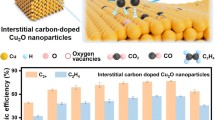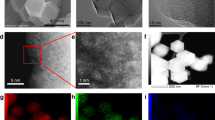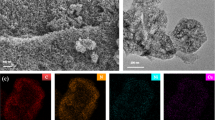Abstract
Electrochemical CO2 reduction reaction (CO2RR) to high-value product, CO, not only provides a key feedstock for the well-established Fischer—Tropsch process but also mitigates the greenhouse effect. However, it suffers from sluggish reaction kinetics, competitive hydrogen evolution reaction, and low selectivity. Herein, we report non-precious Cu-Sn diatomic sites anchored on nitrogen-doped porous carbon (CuSn/NPC) as an efficient catalyst for CO2RR to CO. The catalyst exhibits outstanding selectivity with CO Faradaic efficiency (FE) up to 99.1%, much higher than those of individual Cu (66.2%) and Sn (51.3%) single-atom catalysts. Moreover, high stability is confirmed by consecutive 24 h electrolysis with high selectivity from CO2 to CO. Theoretical calculations reveal an obvious activation of CO2 with weakened C—O bonds and distorted CO2 configuration upon chemisorption on the CuSn/NPC catalyst. It is also suggested CuSn/NPC is more selective for the CO2RR with dominant CO production during the electrolysis, rather than the competing hydrogen evolution reaction.

Similar content being viewed by others
References
Chu, S.; Majumdar, A. Opportunities and challenges for a sustainable energy future. Nature 2012, 488, 294–303.
Davis, S. J.; Caldeira, K.; Matthews, H. D. Future CO2 emissions and climate change from existing energy infrastructure. Science 2010, 329, 1330–1333.
Han, L. L.; Song, S. J.; Liu, M. J.; Yao, S. Y.; Liang, Z. X.; Cheng, H.; Ren, Z. H.; Liu, W.; Lin, R. Q.; Qi, G. C. et al. Stable and efficient single-atom Zn catalyst for CO2 reduction to CH4. J. Am. Chem. Soc. 2020, 142, 12563–12567.
Kauffman, D. R.; Thakkar, J.; Siva, R.; Matranga, C.; Ohodnicki, P. R.; Zeng, C. J.; **, R. C. Efficient electrochemical CO2 conversion powered by renewable energy. ACS Appl. Mater. Interfaces 2015, 7, 15626–15632.
Rofer-DePoorter, C. K. A comprehensive mechanism for the Fischer—Tropsch synthesis. Chem. Rev. 1981, 81, 447–474.
Vennestrøm, P. N. R.; Osmundsen, C. M.; Christensen, C. H.; Taarning, E. Beyond petrochemicals: The renewable chemicals industry. Angew. Chem., Int. Ed. 2011, 50, 10502–10509.
Zhang, Y. Q.; Jacobs, G.; Sparks, D. E.; Dry, M. E.; Davis, B. H. CO and CO2 hydrogenation study on supported cobalt Fischer—Tropsch synthesis catalysts. Catal. Today 2022, 71, 411–418.
Buckley, A. K.; Lee, M.; Cheng, T.; Kazantsev, R. V.; Larson, D. M.; Goddard Iii, W. A.; Toste, F. D.; Toma, F. M. Electrocatalysis at organic-metal interfaces: Identification of structure—reactivity relationships for CO2 reduction at modified Cu surfaces. J. Am. Chem. Soc. 2019, 141, 7355–7364.
Liu, M.; Pang, Y. J.; Zhang, B.; De Luna, P.; Voznyy, O.; Xu, J. X.; Zheng, X. L.; Dinh, C. T.; Fan, F. J.; Cao, C. H. et al. Enhanced electrocatalytic CO2 reduction via field-induced reagent concentration. Nature 2016, 537, 382–386.
Rosen, B. A.; Salehi-Kho**, A.; Thorson, M. R.; Zhu, W.; Whipple, D. T.; Kenis, P. J. A.; Masel, R. I. Ionic liquid-mediated selective conversion of CO2 to CO at low overpotentials. Science 2011, 334, 643–644.
Jiao, Y.; Zheng, Y.; Chen, P.; Jaroniec, M.; Qiao, S. Z. Molecular scaffolding strategy with synergistic active centers to facilitate electrocatalytic CO2 reduction to hydrocarbon/alcohol. J. Am. Chem. Soc. 2017, 139, 18093–18100.
He, Q.; Lee, J. H.; Liu, D. B.; Liu, Y. M.; Lin, Z. X.; **e, Z. H.; Hwang, S.; Kattel, S.; Song, L.; Chen, J. G. Accelerating CO2 electroreduction to CO over Pd single-atom catalyst. Adv. Funct. Mater. 2020, 30, 2000407.
Li, Y. F.; Chen, C.; Cao, R.; Pan, Z. W.; He, H.; Zhou, K. B. Dualatom Ag2/graphene catalyst for efficient electroreduction of CO2 to CO. Appl. Catal. B:Environ. 2020, 268, 118747.
Li, J.; Chen, W. D.; Lin, R.; Huang, M. R.; Wang, M.; Chai, M. S.; Zhu, H. W. Thermally evaporated Ag-Au bimetallic catalysts for efficient electrochemical CO2 reduction. Part. Part. Syst. Charact. 2021, 38, 2100148.
Zhao, Y.; Wang, C. Y.; Wallace, G. G. Tin nanoparticles decorated copper oxide nanowires for selective electrochemical reduction of aqueous CO2 to CO. J. Mater. Chem. A 2016, 4, 10710–10718.
Yang, H.; Hu, Y. W.; Chen, J. J.; Balogun, M. S.; Fang, P. P.; Zhang, S. Q.; Chen, J.; Tong, Y. X. Intermediates adsorption engineering of CO2 electroreduction reaction in highly selective heterostructure Cu-based electrocatalysts for CO production. Adv. Energy Mater. 2019, 9, 1901396.
Sarfraz, S.; Garcia-Esparza, A. T.; Jedidi, A.; Cavallo, L.; Takanabe, K. Cu-Sn bimetallic catalyst for selective aqueous electroreduction of CO2 to CO. ACS Catal. 2016, 6, 2842–2851.
Jiang, X. X.; Wang, X. K.; Liu, Z. J.; Wang, Q. L.; **ao, X.; Pan, H. P.; Li, M.; Wang, J. W.; Shao, Y.; Peng, Z. Q. et al. A highly selective tin-copper bimetallic electrocatalyst for the electrochemical reduction of aqueous CO2 to formate. Appl. Catal. B:Environ. 2019, 259, 118040.
Weng, Z.; Zhang, X.; Wu, Y. S.; Huo, S. J.; Jiang, J. B.; Liu, W.; He, G. J.; Liang, Y. Y.; Wang, H. L. Self-cleaning catalyst electrodes for stabilized CO2 reduction to hydrocarbons. Angew. Chem., Int. Ed. 2017, 56, 13135–13139.
Schreier, M.; Héroguel, F.; Steier, L.; Ahmad, S.; Luterbacher, J. S.; Mayer, M. T.; Luo, J. S.; Grätzel, M. Solar conversion of CO2 to CO using earth-abundant electrocatalysts prepared by atomic layer modification of CuO. Nat. Energy 2017, 2, 17087.
Jiao, J. Q.; Lin, R.; Liu, S. J.; Cheong, W. C.; Zhang, C.; Chen, Z.; Pan, Y.; Tang, J. G.; Wu, K. L.; Hung, S. F. et al. Copper atom-pair catalyst anchored on alloy nanowires for selective and efficient electrochemical reduction of CO2. Nat. Chem. 2019, 11, 222–228.
Reske, R.; Mistry, H.; Behafarid, F.; Roldan Cuenya, B.; Strasser, P. Particle size effects in the catalytic electroreduction of CO2 on Cu nanoparticles. J. Am. Chem. Soc. 2014, 136, 6978–6986.
Ma, M.; Djanashvili, K.; Smith, W. A. Controllable hydrocarbon formation from the electrochemical reduction of CO2 over Cu nanowire arrays. Angew. Chem., Int. Ed. 2016, 55, 6680–6684.
Watanabe, M.; Shibata, M.; Katoh, A.; Sakata, T.; Azuma, M. Design of alloy electrocatalysts for CO2 reduction: Improved energy efficiency, selectivity, and reaction rate for the CO2 electroreduction on Cu alloy electrodes. J. Electroanal. Chem. Interfacial Electrochem. 1991, 305, 319–328.
Kim, D.; Resasco, J.; Yu, Y.; Asiri, A. M.; Yang, P. D. Synergistic geometric and electronic effects for electrochemical reduction of carbon dioxide using gold-copper bimetallic nanoparticles. Nat. Commun. 2014, 5, 4948.
Rasul, S.; Anjum, D. H.; Jedidi, A.; Minenkov, Y.; Cavallo, L.; Takanabe, K. A highly selective copper-indium bimetallic electrocatalyst for the electrochemical reduction of aqueous CO2 to CO. Angew. Chem., Int. Ed. 2015, 54, 2146–2150.
Zhuang, T. T.; Liang, Z. Q.; Seifitokaldani, A.; Li, Y.; De Luna, P.; Burdyny, T.; Che, F. L.; Meng, F.; Min, Y. M.; Quintero-Bermudez, R. et al. Steering post-C—C coupling selectivity enables high efficiency electroreduction of carbon dioxide to multi-carbon alcohols. Nat. Catal. 2018, 1, 421–428.
Manthiram, K.; Beberwyck, B. J.; Alivisatos, A. P. Enhanced electrochemical methanation of carbon dioxide with a dispersible nanoscale copper catalyst. J. Am. Chem. Soc. 2014, 136, 13319–13325.
Roberts, F. S.; Kuhl, K. P.; Nilsson, A. High selectivity for ethylene from carbon dioxide reduction over copper nanocube electrocatalysts. Angew. Chem., Int. Ed. 2015, 54, 5179–5182.
Verdaguer-Casadevall, A.; Li, C. W.; Johansson, T. P.; Scott, S. B.; McKeown, J. T.; Kumar, M.; Stephens, I. E. L.; Kanan, M. W.; Chorkendorff, I. Probing the active surface sites for CO reduction on oxide-derived copper electrocatalysts. J. Am. Chem. Soc. 2015, 137, 9808–9811.
Ren, W. H.; Tan, X.; Yang, W. F.; Jia, C.; Xu, S. M.; Wang, K. X.; Smith, S. C.; Zhao, C. Isolated diatomic Ni-Fe metal-nitrogen sites for synergistic electroreduction of CO2. Angew. Chem., Int. Ed. 2019, 58, 6972–6976.
Yang, X. F.; Wang, A. Q.; Qiao, B. T.; Li, J. Y.; Liu, J.; Zhang, T. Single-atom catalysts: A new frontier in heterogeneous catalysis. Acc. Chem. Res. 2013, 46, 1740–1748.
Zhu, C. Z.; Fu, S. F.; Shi, Q. R.; Du, D.; Lin, Y. H. Single-atom electrocatalysts. Angew. Chem., Int. Ed. 2017, 56, 13944–13960.
Yang, X.; Tat, T.; Libanori, A.; Cheng, J.; Xuan, X. X.; Liu, N.; Yang, X.; Zhou, J. H.; Nashalian, A.; Chen, J. Single-atom catalysts with bimetallic centers for high-performance electrochemical CO2 reduction. Mater. Today 2021, 45, 54–61.
Gao, D. F.; Liu, T. F.; Wang, G. X.; Bao, X. H. Structure sensitivity in single-atom catalysis toward CO2 electroreduction. ACS Energy Lett. 2021, 6, 713–727.
Yun, R. R.; Zhan, F. Y.; Wang, X. J.; Zhang, B. B.; Sheng, T.; **n, Z. F.; Mao, J. J.; Liu, S. J.; Zheng, B. S. Design of binary Cu-Fe sites coordinated with nitrogen dispersed in the porous carbon for synergistic CO2 electroreduction. Small 2021, 17, 2006951.
Huo, S. J.; Weng, Z.; Wu, Z. S.; Zhong, Y. R.; Wu, Y. S.; Fang, J. H.; Wang, H. L. Coupled metal/oxide catalysts with tunable product selectivity for electrocatalytic CO2 reduction. ACS Appl. Mater. Interfaces 2017, 9, 28519–28526.
Kohn, W.; Sham, L. J. Self-consistent equations including exchange and correlation effects. Phys. Rev. 1965, 140, A1133–A1138.
Notario-Estévez, A.; Kozlov, S. M.; Viñes, F.; Illas, F. Electronic-structure-based material descriptors: (In) dependence on self-interaction and Hartree—Fock exchange. Chem. Commun. 2015, 51, 5602–5605.
Kresse, G.; Joubert, D. From ultrasoft pseudopotentials to the projector augmented-wave method. Phys. Rev. B 1999, 59, 1758–1775.
Perdew, J. P.; Burke, K.; Ernzerhof, M. Generalized gradient approximation made simple. Phys. Rev. Lett. 1996, 77, 3865–3868.
Grimme, S. Semiempirical GGA-type density functional constructed with a long-range dispersion correction. J. Comput. Chem. 2006, 27, 1787–1799.
Han, L. L.; Hou, M. C.; Ou, P. F.; Cheng, H.; Ren, Z. H.; Liang, Z. X.; Boscoboinik, J. A.; Hunt, A.; Waluyo, I.; Zhang, S. S. et al. Local modulation of single-atomic Mn sites for enhanced ambient ammonia electrosynthesis. ACS Catal. 2021, 11, 509–516.
Han, L. L.; Liu, X. J.; Chen, J. P.; Lin, R. Q.; Liu, H. X.; Lü, F.; Bak, S.; Liang, Z. X.; Zhao, S. Z.; Stavitski, E. et al. Atomically dispersed molybdenum catalysts for efficient ambient nitrogen fixation. Angew. Chem., Int. Ed. 2019, 58, 2321–2325.
Han, L. L.; Ou, P. D.; Liu, W.; Wang, X.; Wang, H. T.; Zhang, R.; Pao, C. W.; Liu, X. J.; Pong, W. F.; Song, J. et al. Design of Ru-Ni diatomic sites for efficient alkaline hydrogen oxidation. Sci. Adv. 2022, 8, eabm3779.
Han, L. L.; Cheng, H.; Liu, W.; Li, H. Q.; Ou, P. F.; Lin, R. Q.; Wang, H. T.; Pao, C. W.; Head, A. R.; Wang, C. H. et al. A single-atom library for guided monometallic and concentration-complex multimetallic designs. Nat. Mater. 2022, 21, 681–688.
Liu, W.; Han, L. L.; Wang, H. T.; Zhao, X. R.; Boscoboinik, J. A.; Liu, X. J.; Pao, C. W.; Sun, J. Q.; Zhuo, L. C.; Luo, J. et al. FeMo sub-nanoclusters/single atoms for neutral ammonia electrosynthesis. Nano Energy 2020, 77, 105078.
Sun, H. Z.; Zelekew, O. A.; Chen, X. Y.; Guo, Y. B.; Kuo, D. H.; Lu, Q. X.; Lin, J. G. A noble bimetal oxysulfide CuVOS catalyst for highly efficient catalytic reduction of 4-nitrophenol and organic dyes. RSC Adv. 2019, 9, 31828–31839.
Gnana Sundara Raj, B.; Angulakshmi, R.; Baskaran, N.; Wu, J. J.; Anandan, S.; Ashokkumar, M. Pseudocapacitive performance of Mn3O4-SnO2 hybrid nanoparticles synthesized via ultrasonication approach. J. Appl. Electrochem. 2020, 50, 609–619.
Kang, Y.; Park, J. Y.; Kim, D. W.; Kim, H.; Kang, Y. C. Antibacterial and physicochemical properties of Co-sputtered CuSn thin films. Surf. Interface Anal. 2018, 50, 138–145.
Chen, D. T.; Zhang, L. H.; Du, J.; Wang, H. H.; Guo, J. Y.; Zhan, J. Y.; Li, F.; Yu, F. S. A tandem strategy for enhancing electrochemical CO2 reduction activity of single-atom Cu-S1N3 catalysts via integration with Cu nanoclusters. Angew. Chem., Int. Ed. 2021, 60, 24022–24027.
Zhang, T.; Nie, X. W.; Yu, W. W.; Guo, X. W.; Song, C. S.; Si, R.; Liu, Y. F.; Zhao, Z. K. Single atomic Cu-N2 catalytic sites for highly active and selective hydroxylation of benzene to phenol. iScience 2019, 22, 97–108.
Wang, G.; Huang, R.; Zhang, J. W.; Mao, J. J.; Wang, D. S.; Li, Y. D. Synergistic modulation of the separation of photo-generated carriers via engineering of dual atomic sites for promoting photocatalytic performance. Adv. Mater. 2021, 33, 2105904.
Guo, J. Y.; Zhang, W. L.; Zhang, L. H.; Chen, D. T.; Zhan, J. Y.; Wang, X. L.; Shiju, N. R.; Yu, F. S. Control over electrochemical CO2 reduction selectivity by coordination engineering of tin single-atom catalysts. Adv. Sci. 2021, 8, 2102884.
Zhang, Y. Z.; Jang, H.; Ge, X.; Zhang, W.; Li, Z. J.; Hou, L. Q.; Zhai, L.; Wei, X. Q.; Wang, Z.; Kim, M. G. et al. Single-atom Sn on tensile-strained ZnO nanosheets for highly efficient conversion of CO2 into formate. Adv. Energy Mater. 2022, 12, 2202695.
Bulushev, D. A.; Chuvilin, A. L.; Sobolev, V. I.; Stolyarova, S. G.; Shubin, Y. V.; Asanov, I. P.; Ishchenko, A. V.; Magnani, G.; Riccò, M.; Okotrub, A. V. et al. Copper on carbon materials: Stabilization by nitrogen do**. J. Mater. Chem. A 2017, 5, 10574–10583.
Zu, X. L.; Li, X. D.; Liu, W.; Sun, Y. F.; Xu, J. Q.; Yao, T.; Yan, W. S.; Gao, S.; Wang, C. M.; Wei, S. Q. et al. Efficient and robust carbon dioxide electroreduction enabled by atomically dispersed Snδ+ sites. Adv. Mater. 2019, 31, 1808135.
Henderson, M. A. An HREELS and TPD study of water on TiO2(110): The extent of molecular versus dissociative adsorption. Surf. Sci. 1996, 355, 151–166.
Zhong, X. H.; Liang, S. J.; Yang, T. T.; Zeng, G. C.; Zhong, Z. Q.; Deng, H.; Zhang, L.; Sun, X. L. Sn dopants with synergistic oxygen vacancies boost CO2 electroreduction on CuO nanosheets to CO at low overpotential. ACS Nano 2022, 16, 19210–19219.
Chi, S. Y.; Chen, Q.; Zhao, S. S.; Si, D. H.; Wu, Q. J.; Huang, Y. B.; Cao, R. Three-dimensional porphyrinic covalent organic frameworks for highly efficient electroreduction of carbon dioxide. J. Mater. Chem. A 2022, 10, 4653–4659.
Acknowledgements
This work was supported by the startup funding of H. L. X. The XAFS/EXAFS spectra obtained from beamline TPS 44A at National Synchrotron Radiation Research Center (NSRRC) are appreciated. The authors thank Hsiao-Tsu Wang, Wei-Xuan Lin, Chih-Wen Pao, and Way-Faung Pong for the acquisition and analysis of the XAFS data.
Author information
Authors and Affiliations
Corresponding authors
Electronic supplementary material
Rights and permissions
About this article
Cite this article
Liu, W., Li, H., Ou, P. et al. Isolated Cu-Sn diatomic sites for enhanced electroreduction of CO2 to CO. Nano Res. 16, 8729–8736 (2023). https://doi.org/10.1007/s12274-023-5513-5
Received:
Revised:
Accepted:
Published:
Issue Date:
DOI: https://doi.org/10.1007/s12274-023-5513-5




